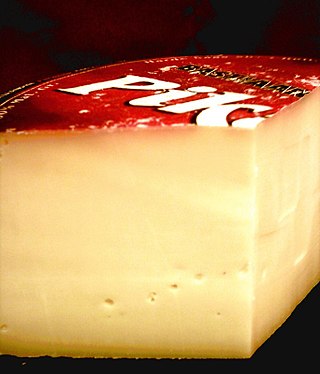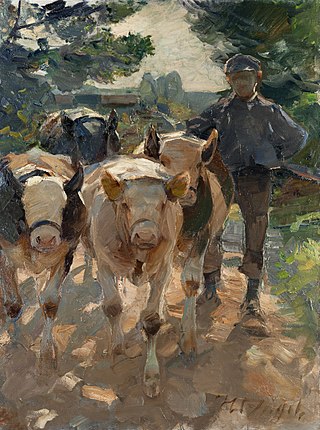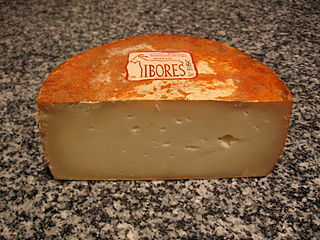
Cheddar cheese is a natural cheese that is relatively hard, off-white, and sometimes sharp-tasting. Cheddar originates from the English village of Cheddar in Somerset.

Gruyère is a hard Swiss cheese that originated in the cantons of Fribourg, Vaud, Neuchâtel, Jura, and Berne in Switzerland. It is named after the town of Gruyères in Fribourg. In 2001, Gruyère gained the appellation d'origine contrôlée (AOC), which became the appellation d'origine protégée (AOP) as of 2013.

Gouda cheese is a sweet, creamy, yellow cow's milk cheese originating from the Netherlands. It is one of the most popular cheeses worldwide. The name is used today as a general term for numerous similar cheeses produced in the traditional Dutch manner.

Annatto is an orange-red condiment and food coloring derived from the seeds of the achiote tree, native to tropical parts of the Americas. It is often used to impart a yellow or orange color to foods, but sometimes also for its flavor and aroma. Its scent is described as "slightly peppery with a hint of nutmeg" and flavor as "slightly nutty, sweet and peppery".

Goat cheese, goat's cheese, or chèvre is cheese made from goat's milk. Goats were among the first animals to be domesticated for producing food. Goat cheese is made around the world with a variety of recipes, giving many different styles of cheeses, from fresh and soft to aged and hard.

Cypriot cuisine is the cuisine of the island of Cyprus, shared by both Greek Cypriots and Turkish Cypriots.

Shanklish, also known as chancliche, shinklish, shankleesh, sorke, or sürke, is a type of cow or sheep milk cheese in Levantine cuisine.

Muenster or munster is a semi-soft cheese from the United States. It is thought to be an imitation of the Alsatian washed-rind Munster cheese, introduced by German immigrants. It is distinct from the processed dairy food Sweet Muenster Cheese. Its name is not related to the German cities of Münster in Westphalia or in Lower Saxony or the Irish province of Munster, but rather to the city of Munster in Alsace, which was part of Germany at the time the cheese was introduced in the US by German immigrants, but is now in France.

Khoa, khoya, khowa or mawa is a dairy food widely used in the cuisines of the Indian subcontinent, encompassing India, Nepal, Bangladesh and Pakistan. It is made of either dried whole milk or milk thickened by heating in an open iron pan. It is lower in moisture than typical fresh cheeses such as ricotta. It is made up of whole milk instead of whey.

Shropshire Blue is a cow's milk cheese made in the United Kingdom.

Picodon is a goats-milk cheese made in the region around the Rhône in southern France. The name means "spicy" in Occitan.

Derby cheese is a mild, semi-firm British cow's milk cheese made in Derbyshire with a smooth, mellow texture and a buttery flavour. Like most of the traditional British hard cheeses it was produced exclusively on farms and was typically sold at a younger age than its more famous cousins Cheddar and Cheshire. It has a pale, golden orange interior with a natural or waxed rind and ripens at between one and six months. In many respects Derby is similar to Cheddar in taste and texture, but with a softer body and slightly higher moisture content. When young it is springy and mild but as it matures subtle sweet flavours develop and the texture becomes firmer.

There are many different types of cheese. Cheeses can be grouped or classified according to criteria such as length of fermentation, texture, methods of production, fat content, animal milk, and country or region of origin. The method most commonly and traditionally used is based on moisture content, which is then further narrowed down by fat content and curing or ripening methods. The criteria may either be used singly or in combination, with no single method being universally used.
Little Derby is a Derby-style cheese made outside Derbyshire, similar in flavour and texture to Cheddar, but without the annatto colouring used in Derby cheese.

Hirtenkäse, or "herder's cheese", is a distinctive cow's milk cheese made in the Allgäu area of Southern Germany.

Pecorino toscano is a firm-textured ewe's milk cheese produced in Tuscany. Since 1996 it has enjoyed protected designation of origin (PDO) status.
Alpujarras cheese is a Spanish cheese from the eastern region of Andalusia, which includes the provinces of Granada, Almería and the Penibética mountain chain. The cheese takes its name from La Alpujarra, a mountainous region which occupies a part of southern Granada province and western Almeria province. This area has a long history and tradition of goatherding. Alpujarras cheese is made from the milk of the White Andalusian domesticated goat.

Casín cheese is a Spanish cheese made in the Principality of Asturias. Its name is covered by a protected designation of origin (PDO). It is made from full-fat, unpasteurized cows' milk from specific breeds, namely Asturian Mountain, Asturian Valley (Asturiana de la Valles), Friesian and any crosses between these breeds. Specifically the geographic area of manufacture is the southern part of Asturias which includes the Redes Natural Park and associated land, this is within the municipalities of Caso, Sobrescobio and Piloña. The cheese is classified as hard and semi-hard, and can be semi-cured or cured. It takes its name from one of the breeds of cattle whose milk is used, in turn named after the town of Caso. The shape of the cheese is a thick disc-shape, sometime more conical, of 10–20 cm diameter and 4–7 cm in height. The weight is between 250 and 1,000 g.

The Ibores cheese is a Spanish cheese made from unpasteurized goats’ milk in Extremadura. It has a Denomination of Origin protection in the European Union and is made specifically in the districts of Ibores, Villuercas, La Jara y Trujillo in the south east of the Province of Cáceres. It is a fatty cheese made exclusively from the milk of Serrana, Verata, Retinta breeds and crosses between them and only from farms registered with the regulatory council. The cheeses are flat cylindrical and measure 5–9 cm (2-3.5 inches) high and 11–15 cm (4-6 inches) across. They weigh from 600 to 1200 g (1-2 lbs).

















